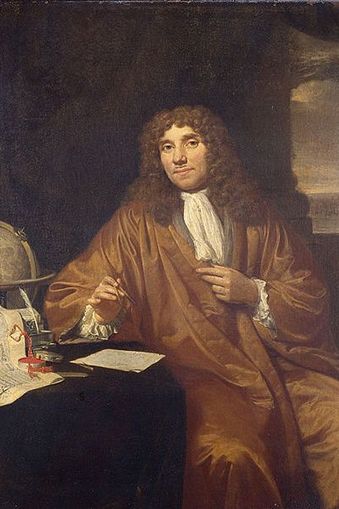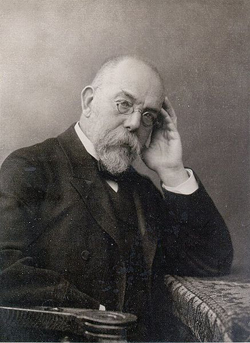A Brief History of Biofilms
Biofilms were actually observed long ago, before anyone had a clue what they were or how important they were. Indeed, at the time, no one really new what science was, let alone biofilms. Scientists, who were generally just hyper-inquisitive people who had other day jobs (or, more likely, were hyper-inquisitive persons of independent means) had few tools (e.g., microscopes) for studying things that were, well, microscopic.

But science and scientists had to start somewhere.
Antonie van Leeuwenhoek
One of the early scientists to study microscopic life was the Dutchman, Antonie van Leewenhoek. He was well known for his ability to build microscopes that were quite a bit better than the run of the mill, the design of which he held as a closely guarded secret.
After utilizing one of his own microscopes in 1684 he remarked in a report to the Royal Society of London on the vast accumulation of microorganisms he was able to see in dental plaque : "The number of these animalcules in the scurf of a man's teeth are so many that I believe they exceed the number of men in a kingdom." (He was right).
In some ways it's too bad that his early work did not receive more recognition in our day. For one thing, you just have to love that word scurf used by van Leewenhoek. It is so much more colorful than biofilm. And animalcules? Much cuter than microbes.
You can find out a lot more about van Leewenhoek through a Web search. Among the interesting links are these: 1, 2, 3, 4. As with many things on the Web, accounts differ depending on the source. Even his first name is spelled differently in different sources, but then, he probably spelled his name differently at times as well. Spelling was not a well-developed art in van Leeuwenhoek's day.
Alas, of the several hundred microscopes van Leeuwenhoek constructed in his life-time, only about 10 survive in museums. His only mistake was to use silver and gold in their construction. As good relatives, his next of kin apparently sold them for their worth in gold and silver, not for their worth as scientific instruments. The word on the street is that microscopes of that caliber were not constructed again for over 200 years.
Robert Koch

A couple of hundred years after van Leeuwenhoek, the German scientist Robert Koch (1843 - 1910) began to isolate and study individual bacteria, and he laid the groundwork for the study and treatment of many serious diseases. After his initial success with anthrax and tuberculosis, his approach for studying bacteria-causing diseases became the standard for all microbial infectious disease research. In order to show that a particular organism is responsible for a particular disease the following procedure must be followed:
- The suspected organism must be present in all cases of the disease.
- From the diseased host, a single type of bacterium must be isolated and grown in pure culture.
- When introduced into a susceptible host organism, this bacterium must cause the symptoms of the disease.
- If disease symptoms are observed, the syspected organisms must be re-isolated and shown by various tests to be identical to the originally isolated bacterium.
As a result, since the time of Koch, microbiologists have been investigating bacteria almost exclusively in this way—in a single species planktonic (water-based) culture. This "pure culture paradigm" became so ingrained in universities and medical schools that the idea arose that, "if you were not doing pure culture microbiology, you weren't doing science”.
This pure culture approach was enormously successful, affirming the wisdom of Koch and his contemporaries and leading to a "Golden Age" of microbiology in which the agents of many devastating human pathogens, including tuberculosis, cholera and diphtheria, were identified and largely conquered. For his pioneering work, Koch was awarded the Nobel Prize in Physiology or Medicine in 1905 (the term "Physiology or Medicine" does not mean that we don't know which it was; rather that was the actual name of the prize, indicating that the work being awarded this Nobel Prize had to be in physiology or medicine).
The best link for learning more about Koch is the Nobel-prize.org website.


